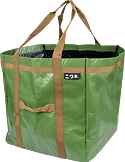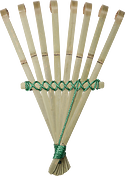One of the best bits about manning the stand at the Chelsea Flower Show* is the opportunity to hear how customers use the products they already own and to demonstrate which useful tools they could or should be using, but at present do not use, either because they don’t know they exist, they don’t know what do with them, or they imagine that, because the tools have been designed with specific uses in mind, using them is too specialist an art and best left to the professionals.
This is an understandable bit of logic, but ultimately flawed. Looking at tools like Topiary Clippers, you might just as well focus on the simplicity of the designs and conclude that using them will be equally straightforward. Like most things in life, the truth lies somewhere between the two conclusions, but when it comes to clipping box – which is what many gardeners are building up to do at the start of June – the worst that can happen is you end up with a wonky clip.
Just as with a dodgy haircut, the plant will grow back and you will probably have learned a thing or two from the mistake, so as long as you’re in your own garden and nobody is paying you, no harm done. More likely you’ll discover that with the right tools it’s incredibly simple to keep yew, box and other shaped shrubs and hedges neat and tidy without calling in the pros.

Jake Hobson tests out the new Niwaki Hakari curved blade clippers. Tailor-made for box balls – we challenge you to cut a straight line!
But which tools? Let’s discuss the options:
Use topiary shears (or garden shears if you’re on a budget) for establishing or refining the general shape. The Niwaki Garden Shears, fashioned from SK carbon steel, are great garden all-rounders, but if you use them for too much general purpose hacking before clipping season you may be disappointed with their performance. Kept in top condition and set aside for clipping alone, they make an affordable solution.
The Niwaki Topiary Shears are more expensive and better for a number of reasons, not least they are made from higher grade ‘blue paper’ steel, which is Japanese knife-quality and ideal for slicing cleanly through soft new growth, with more of it thanks to their longer blades. They are also better balanced for sculpting and shaping rather than just reducing in size.
Next up, topiary clippers for refining and tidying up the shapes you’ve created with the shears. Effectively handheld shears, they range in craftsmanship (and therefore price) from the Sentei Topiary Clippers to the curved-blade Hakari Clippers. Like most things in life, you get what you pay for (and you pay for what you can afford) but if you want to balance performance and longevity with price, we recommend the Niwaki GR Pro Topiary Clippers or the new Daikiba Clippers, plus a few cleaning and sharpening extras.
Wondering how to actually use the tools? The first rule is to get stuck in and figure it out yourself, but if that’s too daunting a task we’ve put together a quick beginner’s guide to box clipping – read more here, or scroll on down for tidying up accessories.

Box Clipping: a beginner’s guide
Box Clipping: a beginner’s guide
Although aimed at beginners, seasoned old pros should find something useful here too, and at the very least enjoy tut-tutting and disagreeing, for the first rule of box clipping is there are no rules in box clipping.

SHARPEN YOUR SHEARS WITH JAKE
And because you need to keep your tools clean and sharp if they are to perform adequately, Jake demonstrates how to sharpen shears without the tears. Click above to watch.

VIDEO: Choosing the right Garden and Topiary Shears
Watch our guide to choosing the right topiary shears (for establishing the main shape): click the link above.














